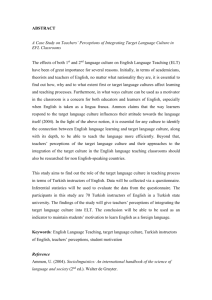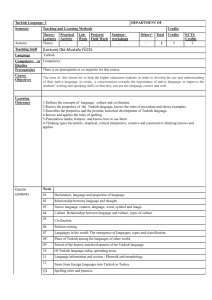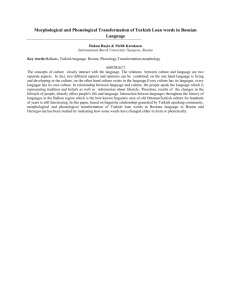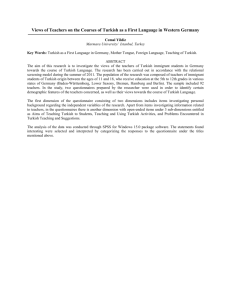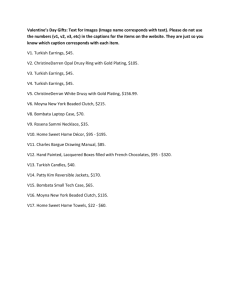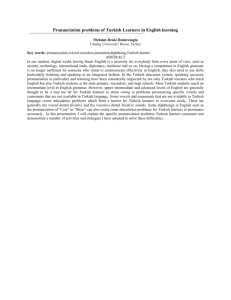e-learning Turkish
advertisement
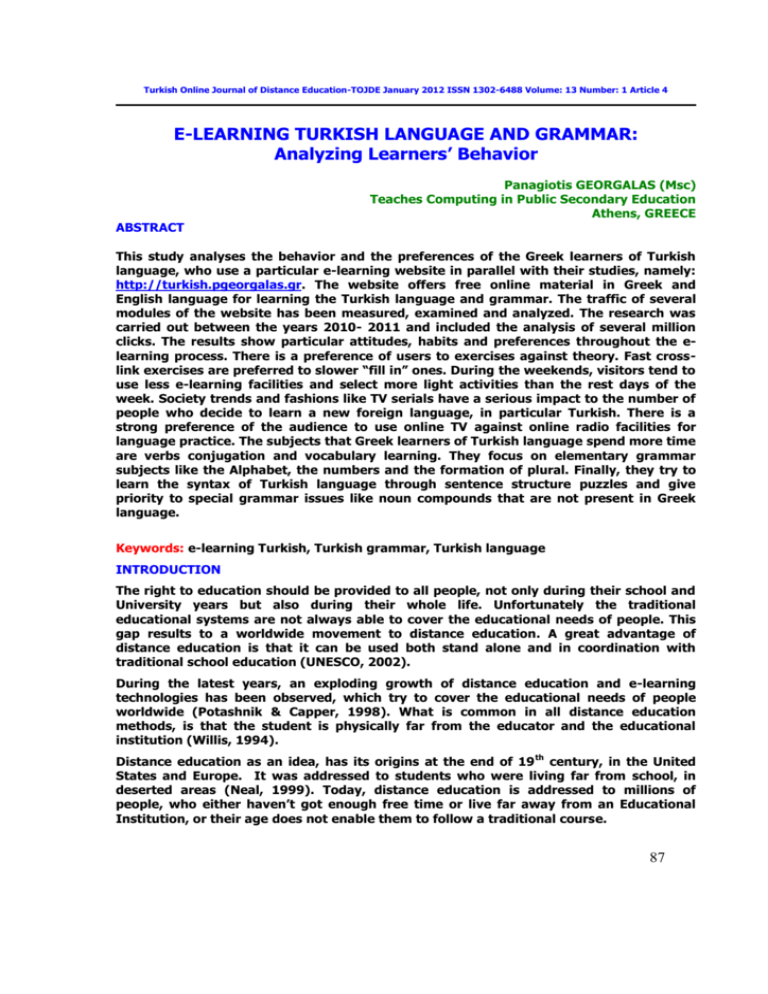
Turkish Online Journal of Distance Education-TOJDE January 2012 ISSN 1302-6488 Volume: 13 Number: 1 Article 4 E-LEARNING TURKISH LANGUAGE AND GRAMMAR: Analyzing Learners’ Behavior Panagiotis GEORGALAS (Msc) Teaches Computing in Public Secondary Education Athens, GREECE ABSTRACT This study analyses the behavior and the preferences of the Greek learners of Turkish language, who use a particular e-learning website in parallel with their studies, namely: http://turkish.pgeorgalas.gr. The website offers free online material in Greek and English language for learning the Turkish language and grammar. The traffic of several modules of the website has been measured, examined and analyzed. The research was carried out between the years 2010- 2011 and included the analysis of several million clicks. The results show particular attitudes, habits and preferences throughout the elearning process. There is a preference of users to exercises against theory. Fast crosslink exercises are preferred to slower “fill in” ones. During the weekends, visitors tend to use less e-learning facilities and select more light activities than the rest days of the week. Society trends and fashions like TV serials have a serious impact to the number of people who decide to learn a new foreign language, in particular Turkish. There is a strong preference of the audience to use online TV against online radio facilities for language practice. The subjects that Greek learners of Turkish language spend more time are verbs conjugation and vocabulary learning. They focus on elementary grammar subjects like the Alphabet, the numbers and the formation of plural. Finally, they try to learn the syntax of Turkish language through sentence structure puzzles and give priority to special grammar issues like noun compounds that are not present in Greek language. Keywords: e-learning Turkish, Turkish grammar, Turkish language INTRODUCTION The right to education should be provided to all people, not only during their school and University years but also during their whole life. Unfortunately the traditional educational systems are not always able to cover the educational needs of people. This gap results to a worldwide movement to distance education. A great advantage of distance education is that it can be used both stand alone and in coordination with traditional school education (UNESCO, 2002). During the latest years, an exploding growth of distance education and e-learning technologies has been observed, which try to cover the educational needs of people worldwide (Potashnik & Capper, 1998). What is common in all distance education methods, is that the student is physically far from the educator and the educational institution (Willis, 1994). Distance education as an idea, has its origins at the end of 19 th century, in the United States and Europe. It was addressed to students who were living far from school, in deserted areas (Neal, 1999). Today, distance education is addressed to millions of people, who either haven’t got enough free time or live far away from an Educational Institution, or their age does not enable them to follow a traditional course. 87 Nowadays, a vast variety of courses, subjects and solutions is offered to students and potential students. In addition, specialization and customization is usually provided to fully cover different student’s needs. E-learning applications have mainly been developed for online distance education, with an extensive usage of electronic media (Sandars, 2006). Recent developments in Web technologies and modern Artificial Intelligence techniques can provide higher-level services to students. Furthermore, there has been a revolution to Web-based education, as educational technology is step by step implemented into Web-based education. Modern web applications have brought classroom independence and platform independence. Nowadays, multiple authoring tools are offered for the development of Web-based courses, combined with cheap and efficient storage and distribution of course materials. (Devedzic, 2004). Foreign language teaching was one of the main sectors that Information and Communication Technologies (ICT) were integrated into distance learning courses. During the latest decades more and more elaborate Computer Assisted Language Learning (CALL) applications have been developed and offered to students. The wealth of information available on the Web enables teachers and learners access to language learning resources like never before. Online journals, newspapers, magazines, provide authentic material for language learners (Morrison, 2002). At the same time, teachers can find lesson plans and ideas, exercises, assessment tools, and other materials to use in their classroom. But on the other hand, increased technological sophistication does not always result to increased pedagogical effectiveness (Salaberry, 2001). Most often elaborated e-learning computer applications can’t motivate students to learn, as they can’t effectively embed technology into teaching. When a potential student needs to learn a foreign language, different than the most popular ones, he/she has to overcome several problems. Firstly, it is difficult to find a tutor who can effectively teach the requested language. In addition, there are limited opportunities for practice and communication with native speakers. It is also difficult to find effective learning material like books, exercises and examples. Finally, it is almost impossible sometimes to form groups of students of the same level to learn a not very popular foreign language. Especially in Greece, this problem becomes more intense because of the many islands and rural areas (Chatziplis, Vassala, & Lionarakis, 2007). Information and communication technologies can support e-learning, giving at the same time new possibilities and crucial assistance to the student. Information Technology applications to foreign languages have seen a tremendous growth during the last decades (Chapelle, 2001). Special software tools, like text to speech conversion and speaking avatars provide the student the chance to listen to a natural speaker of the foreign language in real life conditions (Garrison, 2003). In any case, what makes students learn a new subject isn’t the computer itself, but some carefully created real life scenarios and the interaction between students and those models (Kozma, 2001). Consequently, there is always a challenge to explore the new possibilities that computers and Web technology can bring to foreign language teaching. This challenge becomes greater for languages different than English, where less work has been done. The lack of online learning applications, with detailed theory, large number of exercises and multiple examples, in order to teach and learn the grammar and the syntax of Turkish language, is a serious problem for potential and active learners. This fact may bring difficulties or distract many people from learning Turkish or any other non-widely taught language. 88 As it concerns Turkish language, several online courses are offered from official sources leading to a certificate. Anadolu University is one of the most well known course providers. According to a study on this program (Altunay, 2010), distance learning courses are beneficial to language learning but they cannot be as effective as traditional courses or learning a language with natural speakers. Tömer language school from Ankara University also provides distance learning courses leading to a certificate. There are also some unofficial online Turkish language resources from individual educators and private companies. These include classic websites, forums, social media communities and even mutual language teaching exchanges. The educational approaches vary from educator to educator. Most of the above resources are addressed to English speaking students. There are only a few online resources for Greek speaking learners of Turkish language. For this reason a Web application was created, whose purpose is to use multiple teaching approaches to achieve the effective learning of Turkish language and grammar. Colours, drawings, videos, avatars and pictures are widely used throughout the project in order to combine learning and entertainment. Furthermore, this distance learning method tries to take away the stress from the students because everything is online, so they can use it at home, any time of the day. Finally, learners can keep their own pace on study and focus on their special interests. The aim of this study is to use statistical data from the website in order to explore learners’ preferences, interactions with society trends and find out what Greek students expect from a Turkish language e-learning website. THE WEBSITE The website application is addressed to Greek and international learners of Turkish language as a learning tool and especially to those who do not have adequate access to Turkish language resources. This application, as almost all e-learning applications, does not intend to substitute the traditional teacher (Jones, 1986) but to open some new ways in distance education. The methodology that has been adopted intends to be student oriented rather than examination oriented. Grammar rules and sources of mistakes are analyzed in most modules. Feedback and help is constantly provided to students. The access to the website is free and no subscription is needed. There are two language versions of the website: A Greek and an international (English). Booth versions host almost the same learning material. The Greek version, analyzed in this study, can be found at the address: http://turkish.pgeorgalas.gr The website is suitable for statistical analysis as it is visited monthly by more than 25,000 visitors who make about 170,000 clicks (November 2011). Learners of Turkish language can find it easily, as there are distinct links to it from the Greek version of Wikipedia at “Τουρκική Γλώσσα (Turkish language)” article and from many local and international language resource centers, libraries and directories. In addition it has kept for a long time the first places in the results of search engines on many Greek keywords having to do with Turkish language, Turkish grammar etc. WEBSITE CONSTRUCTION AND PEDAGOGIC APPROACH The grammar rules analyzed in the website are based on official Turkish grammar books (Göksel, 2005 & Lewis, 2000). 89 The learning approach that has been adopted follows the scheme: theory, examples, exercises, learning activities. Different types of exercises are provided, like multiple choice, cross link, fill in etc. The most appropriate type of exercise is chosen for every subject. The content is organized in well structured units that can be reached through a drop down menu. All exercises modules have been created with Javascript and VBscript and receive data from a database in the background. The grammar subjects covered in the website are: Turkish Alphabet, pronouns, verbs, nouns, adjectives, adverbs, date and time, relative spatial positions, suffixes and Turkish sentence structure. There are also vocabulary and language learning activities. VOKI technology has been embedded into the website for the creation of audiovisual material. Turkish speaking avatars have extensively been used along with the technology “text to speech”. Both male and female voices are used in order to familiarize learners with the Turkish pronunciation. At the verbs section, for every verb, there is a detailed explanation of the rules that are applied for the conjugation in different tenses. In this way, the learning environment becomes more user-friendly and simulates a teacher. A classic grammar book is difficult to follow this approach because of the lack of space. In a traditional book, only a few cases can be examined for each grammar rule. On the contrary, a computer database application can use an algorithmic approach in order to create almost infinite examples and explain in detail the grammar rules for every verb, noun adjective etc. that a student may seek. Users can get extra help at multiple choice exercises, as they not only get the correct answer, but also feedback for the violated rule, in case of a wrong answer. In addition, every time a user asks for a new exercise, a completely new random set of exercises is automatically produced. In this way, learner’s interest is kept undiminished because the software in the background can provide endless combinations of exercises. In every set of exercises, care has been taken so that almost all different grammar cases and exceptions are examined. Users can also select their language level (beginner or advanced). With this option, learning material is customized to learner’s needs. Furthermore, rss feeds and podcasts from carefully selected sources are used, in order to make the content more live and up to date. For example, there are news from Turkish online newspapers, weather forecast, top books, top films and songs in Turkey in real time. In this way, students can approach better Turkish culture and society. There is also a section with shared Greek and Turkish songs (with video and lyrics), proverbs, and common place names, aiming to make the learning process more familiar to Greek learners of Turkish language. The visitors of the site can practice their language skills watching live Turkish TV channels and listen to Turkish radio stations. Finally, collaborative learning can be achieved through the embedded forums. The following questions were posed in the study: 1. Are there any special days of the week that users prefer for e-learning? 2. During the weekends, do users prefer visiting more light subjects, like listening to songs rather than studying classic grammar subjects? 3. Cross link exercises Vs Fill in exercises. What do users prefer? 4. Theory Vs exercises. When learning the vocabulary, do users prefer studying the theoretical part or doing exercises? How popular are the vocabulary learning modules? 5. Do society trends and fashions (i.e. TV serials) have an influence to the population of a country on their decision to learn a new language? 6. Do users prefer to watch live Turkish TV or listen to Turkish radio stations in order to practice their language skills? 8. Which are the most popular grammar issues? What can be concluded? 90 METHODOLOGY The research was based on website’s traffic. The sample contains statistical data that were collected from the site with Google Analytics tool. The data have been taken between the years 2010 and 2011. ANOVA test was applied for each question that needed statistical analysis. In order to ensure the validity and the reliability (Fraenkel & Wallen, 2008) of the research, special care has been taken by the researcher, so that the sample data were unbiased. Testing and internal traffic that could influence the results was carefully excluded. During the study period, website traffic wasn’t guided to any special modules with preorganized events or campaigns. On the contrary, visitors could make their own patterns from subject to subject according to their educational needs. The large number of clicks can ensure statistical conclusion validity. RESULTS Are there any special days of the week that users prefer for e-learning? The website traffic showed some volatility during the days of the week. This observation leaded to the examination for the days of the week that users prefer to study with the Turkish e-learning application. For each day of the week, the total number of clicks at the main page of the website, were collected for a period of 52 weeks. According to the results shown in Table: 1, the days with the less clicks are Saturday and Sunday. So, the conclusion is that Greek learners of Turkish language tend to study online more from Monday to Friday. P-value is small enough to ensure that website traffic is day dependable despite the volatility shown in Figure: 1. Table: 1 Traffic of the main page of the website for each day of the week Day of the week Monday Tuesday Wednesday Thursday Friday Saturday Sunday Days Total clicks 52 52 52 52 52 52 52 6496 6704 7096 6425 5864 5001 5657 Average clicks per day 124.92 128.92 136.46 123.56 112.77 96.17 108.79 Standard deviation 56.02 55.66 58.53 52.07 48.28 44.38 53.73 P-value: 0.0023 91 Traffic of the main page of the website for each day of the week 250 Clıcks 200 150 Monday Tuesday Wednesday Thursday 100 Friday Saturday Sunday 50 0 Day of the week Figure: 1 Traffic of the main page of the website for each day of the week During the weekends, do users prefer visiting more light subjects, like listening to songs rather than studying classic grammar subjects? In the website there is a practice activity that contains some shared Turkish and Greek songs, with lyrics and embedded videos. In order to estimate if users prefer these kinds of activities during the weekend, an ANOVA test was applied. The percentage of song clicks to the total clicks on the website, were collected for each day of the week. The period of study was one year (52 weeks). The focused parameter here is the mean value. Table: 2 Song clicks to total website clicks percentage for each day of the week Day of the week Monday Tuesday Wednesday Thursday Friday Saturday Sunday 52 Days Song clicks /Total clicks % Standard deviation 52 52 52 52 52 52 6.94 7.52 6.88 7.45 8.45 10.04 3.43 4.08 3.02 2.65 4.02 3.55 8.64 3.63 P-value: 0.0000254 The very low P-value indicates that “listening to songs” activities are day dependable. The conclusion is that users prefer doing more “light” activities during the weekends, like listening to songs, rather than studying more classical grammar and language subjects. Cross link exercises Vs Fill in exercises. What do users prefer? In every language, there is always a group of high-frequency words that cover a significant proportion of running words in spoken and written texts and can be found in all kinds of uses of the language (Nation, 2001). A commonly used and quite effective technique for learning vocabulary in a foreign language is to organize the words into groups with a common theme or characteristic (Oxford, 1990). 92 So, it becomes easier for the student to memorize and learn them. Online vocabulary exercises can arouse learners’ interest for a foreign language, as long as they are carefully documented (Yip, 2006). A major activity in the website and one of the most popular ones is learning Turkish vocabulary. Two different kinds of exercises are offered to the students: Cross link and Fill in exercises as in Figures 2&3. Figure: 2 A typical cross link vocabulary exercise Figure: 3 A typical fill in vocabulary exercise Statistical data with the traffic of the above exercises were collected for a period of 6 months. Table: 3 shows that users strongly prefer “Cross link” exercises to “Fill in” ones, despite the volatility of the daily traffic. Table: 3 Traffic comparison between Cross link and Fill in exercises Exercise type Cross link Fill in Period of study 181 days 181 days Total clicks 25464 3678 Average clicks per day 140.69 20.32 Standard deviation 88.90 29.14 P-value: 2.87·10-49 Theory Vs exercises. When learning the vocabulary, do users prefer studying the theoretical part or doing exercises? How popular are the vocabulary learning modules? A new question was emerged as an enhancement of the previous question. When users study the vocabulary of Turkish language, do they mostly prefer reading the theoretical part, studying lists of words and phrases organized by subject or doing exercises and in what ratio? 93 Figure: 4 Learning Turkish vocabulary-The theoretical part and fill in) were collected for a period of 6 months. Table: 4 Traffic comparison between theory and exercises modules Activity type Theory Exercises Period of study 181 days 181 days Total clicks 26241 Average clicks per day 144.98 29632 163.71 Standard deviation 65.12 92.63 P-value: 0.027 Table: 4 shows a small preference to exercises. This preference could be explained from the need of the students to practice their language skills and the lack of many online exercises on Turkish grammar. During this period both vocabulary learning modules received totally 55873 clicks. At the same time the Greek version of the website received totally 399112 clicks. This leads us to the conclusion that almost 14% of the visitors’ activity had to do with learning Turkish vocabulary. This secondary result shows the importance of vocabulary activities in an online language learning application. Do society trends and fashions (i.e. TV serials) have an influence to the population of a country on their decision to learn a new language? On June 15 2011, the transmission of several Turkish TV serials started on Greek television. According to TV polls, most of them became very popular to the Greek audience. As it was shown at question 1, the e-learning Turkish language and grammar website, usually collects less traffic during the weekends and holidays. But since the Turkish serials had started, a sudden increase was observed to the number of unique visitors and the total number of clicks. 94 To investigate this influence, the number of clicks on the main page two months before serials starting date, was compared with the total number of clicks two months after the transmission of serials had started on Greek television. This contains the periods 15/04/2011 - 15/06/2011 and 16/06/2011 - 17/08/2011. Table: 5 Traffic comparison for main page before and after Turkish TV serials starting date TV serials starting date Period Total clicks Before 62 days 62 days After Standard deviation 8242 Average clicks per day 130.83 10817 171.70 36.90 31.84 P-value: 8.14·10-10 The ANOVA test showed that the “TV serials” factor had a great impact on the popularity of the website. The conclusion is that the interest of Greek people for Turkish language and the consequent total number of clicks was significantly increased after the starting date of Turkish TV serials.A more generalized conclusion is that society trends and fashions generally have an impact to the number of people who select to learn a new foreign language. 6. Do users prefer to watch live Turkish TV or listen to Turkish radio stations in order to practice their language skills. The website offers many opportunities for online practice. Some of the most popular Turkish TV and radio stations that transmit their program online have been embedded into the website. The learners of Turkish language can practice their language skills watching online TV and listening to radio live. The question is which one of the two activities is the most popular. The focused parameter here is the number of clicks on each media source. The period of study was one month. Table: 6 Traffic comparison between Radio and TV modules Activity type Radio TV Period of study 31 days 31 days Total clicks 765 3252 Average clicks per day 24.68 104.90 Standard deviation 11.31 38.02 P-value: 1.97·10-16 Table: 6 shows a strong preference to TV channels against radio stations. Which are the most popular grammar issues of the website? What can be concluded? The website covers the biggest part of Turkish grammar with theory, exercises and examples. Traffic analysis (Table: 7) showed that the most popular exclusively grammar issues are: 95 Table: 7 Popularity of Turkish Grammar issues in the website for the period 01/12/2012 – 30/11/2011 Grammar Issues Learn to Conjugate Verbs Learning Turkish Pronouns Learning the Alphabet Learning the Numbers Forming Noun Compounds Learning Sentence Structure with Puzzles Forming the Plural Clicks 163,028 104,792 91,032 46,734 16,493 13,209 Popularity % 11.31% 7.27% 6.32% 3.24% 1.14% 0.92% 11,430 0.79% Total website clicks during this period: 1,441,106 Learn to conjugate verbs. The website implements a special method for learning the conjugation of Turkish verbs in all tenses (Figure 5). There is a database that contains the most important verbs of Turkish language. The beginners can see the only some basic verbs, whereas a bigger list is offered to advanced learners. A special software in the background, conjugates automatically the selected verb, in affirmative, negative, question and negative question. At the same time the rules of conjugation are explained to the user step by step. Verbs hold a key role in every language. It is impossible to communicate in a foreign language if we have not understood the formation and the usage of verbs. Especially in Turkish language, there are some tenses i.e. Geniş zaman (Kaili, 2008), that are used in a different manner than in Greek language. This may explain the popularity of this activity. 96 Figure: 5 Turkish verbs - Explaining the rules of conjugation Turkish Alphabet, pronouns and numbers. In the website, there are several activities that present in detail the above subjects. Text and sound have extensively been used to help the learners of Turkish language. The large interest to these activities probably reveals that the greatest part of users is still in their first steps into Turkish language studies. Nouns The most popular subject in nouns that users want to learn is the formation of Plural. This probably reveals that most users are still beginners in their Turkish language studies. In addition there is a special interest in Turkish noun compounds (belirtisiz tamlamalar). In Greek and most European languages, such a grammar issue does not exist. So, as a really challenging subject to learn, it attracts many visitors who have difficulties to understand the formation and the usage of Turkish noun compounds. iv. Turkish sentence structure. Previous CALL studies have shown that online quizzes can help students to understand more quickly the structure of a sentence in a foreign language (Reiko, 2002).The website helps the users to learn Turkish sentence construction through phrase puzzles. Sentences in most European languages have the structure: Subject – Verb – Object. On the contrary, Turkish sentence structure is: Subject – Object - Verb. In addition, Turkish is an agglutinating language. There are no articles and genders. To show the person and the possession, suffixes are added at the end of the words. As a matter of fact, a Greek learner of Turkish language must learn to speak without articles, genders etc. (Millas, 2008). Furthermore, in Turkish language the verbs “to be” and “to have” do not exist. Word order is important in Turkish language, whereas in Greek language word order is not of great importance (Millas, 2008). This different structure seems to become a major difficulty to Greek and other European learners of Turkish language and may explain the popularity of this activity. Figure : 6 A phrase puzzle exercise CONCLUSIONS This study showed that the amount of time spent on the e-learning website, by Greek learners of Turkish language, is day dependable. The subjects that users prefer to study are also day dependable. Generally users tend to study less and prefer more light subjects, like listening to songs, during the weekends. 97 A partial explanation of the above finding could be that learners of Turkish language generally use their computers at home during the weekend, whereas the rest days of the week may visit the website from their work or educational institution’s computers. Another explanation could be that users tend to combine learning and entertainment more during the weekend, rather than the rest days of the week. In addition, according to the findings, there is a need for Turkish grammar online exercises for practice. From the different types of exercises, online learners generally prefer doing fast exercises that include no typing or minimal typing, even if they get help with special Turkish characters. Of course the role of dictation with “fill in” exercises is very important in learning a foreign language. Here emerges the importance of a traditional teacher who will guide the students to all types of exercises and not just let them select some fast ones. Another interest finding was how TV serials motivated many Greek people to start learning the Turkish language. According to Table: 5, since Turkish serials started, there was a sudden increase by at least 20% of the people who visited the website, trying to find material for Turkish language. As for online resources, streaming TV seems to attract more language learners than online radio. Nowadays most users have fast Internet access, so they are able to view TV channels without interruptions. A final conclusion is that the majority of users seek introductory Turkish grammar and language material. An explanation of the above finding could be that people generally want to have an introductory contact with a foreign language before they decide to take a course. Among the grammar subjects, users mostly focus on verbs, which keep a key role to every language and especially on verb conjugation rules. They also try to clarify some special grammar issues, like noun compounds, that do not exist in Greek and other European languages. Subjects that students are not familiar with, generally need more time and more examples and exercises for comprehension. Finally, visitors look for practice exercises on Turkish sentence structure through puzzles. This is probably the result that Turkish sentence structure is very different from the sentence structure of most European languages. This research could be enhanced in the future with findings from traffic analysis of international learners of Turkish language. REFERENCE Altunay, D. & Mutlu M.E. (2010). Distances et savois, ISSN 1765-0887, Vol. 8, No 3, 2010, pages 463-473 Chapelle, C. (2001). Computer Applications in Second Language Acquisition, Cambridge University Press, Cambridge. Chatziplis P., Vassala P., Lionarakis A. (2007), Distance Learning in Secondary Education, Open Education: the Magazine for Distance Learning and Educational Technology, Vol. 3, No. 1 (2007) Devedzic, V. (2004). Education and the Semantic Web, International Journal of Artificial Intelligence in Education, Volume 14 Issue 2, April 2004. 98 Fraenkel, J. R., & Wallen, N. E. (2008). How to design and evaluate research in education (7th ed.). New York: McGraw-Hill. Garrison, D.R., & Anderson T. (2003). E-learning in the 21st Century: A Framework for Research and Practice, Routledge/Falmer, New York Göksel, A. & Kerslake C., (2005). Turkish: A Comprehensive Grammar. London Routledge Kaili, H. (2008). How long does Geniş zaman last? Trying to redeterminate Geniş zaman. In: Languages for Intercultural Dialogue. 7-9/11/2008, Nicosia: University of Cyprus. Lewis G.L. (2000). Turkish Grammar, 2nd edition, Oxford University Press Millas, H. (2008). Advantages and disadvantages of teaching the language of the “Other”: Greek-Turkish. In: Languages for Intercultural Dialogue. 7-9/11/2008, Nicosia: University of Cyprus. Morrison, S. (2002). Interactive language learning on the web. ERIC Digest. Retrieved February 8, 2004, from ERIC database. Nation, I. S. P. (2001). Learning vocabulary in another language. Cambridge: Cambridge University Press Neal, E. (1999). Distance education. National Forum, 79 (1), 40-44. Oxford, R. L. (1990). Language learning strategies: What every teacher should know. Rowley, MA: Newbury House. Potashnik, M. & Capper, J. (1998). Distance education: growth and diversity. Finance & Development, March, 35 (1), 42-46. Reiko I., Hannon C. (2002). The effect of online quizzes on learning Japanese, CALICO Journal, 19(3): 551-561 Salaberry M. (2001). The use of technology for second language learning and teaching: a retrospective. The Modern Language Journal, 85(1) Sandars, J. (2006). e-Learning for GP educators, books.google.com UNESCO (2002). Open and Distance Learning. Trends, Policy Considerations. Paris: UNESCO. and Strategy Willis, B., ed (1994). Distance Education: Strategies and tools. Englewood cliffs, NJ: Educational Technology Yip, F. W. M., & Kwan, A. C. M. (2006). Online vocabulary games as a tool for teaching and learning English vocabulary. Educational Media International, 43(3), 233-249 99


